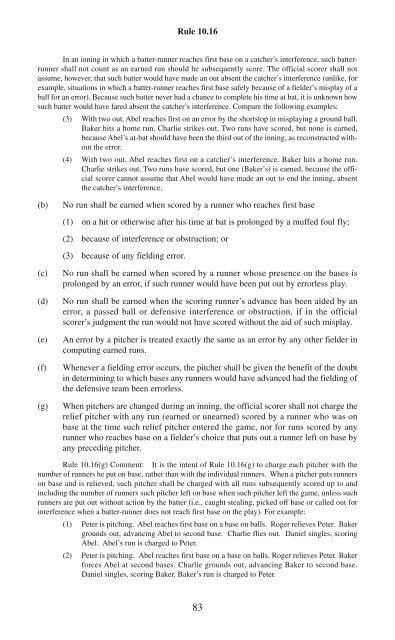OFFICIAL BASEBALL RULES
1SPD1Aq
1SPD1Aq
Create successful ePaper yourself
Turn your PDF publications into a flip-book with our unique Google optimized e-Paper software.
Rule 10.16In an inning in which a batter-runner reaches first base on a catcher’s interference, such batterrunnershall not count as an earned run should he subsequently score. The official scorer shall notassume, however, that such batter would have made an out absent the catcher’s interference (unlike, forexample, situations in which a batter-runner reaches first base safely because of a fielder’s misplay of aball for an error). Because such batter never had a chance to complete his time at bat, it is unknown howsuch batter would have fared absent the catcher’s interference. Compare the following examples:(3) With two out, Abel reaches first on an error by the shortstop in misplaying a ground ball.Baker hits a home run. Charlie strikes out. Two runs have scored, but none is earned,because Abel’s at-bat should have been the third out of the inning, as reconstructed withoutthe error.(4) With two out, Abel reaches first on a catcher’s interference. Baker hits a home run.Charlie strikes out. Two runs have scored, but one (Baker’s) is earned, because the officialscorer cannot assume that Abel would have made an out to end the inning, absentthe catcher’s interference.(b)(c)(d)(e)(f)(g)No run shall be earned when scored by a runner who reaches first base(1) on a hit or otherwise after his time at bat is prolonged by a muffed foul fly;(2) because of interference or obstruction; or(3) because of any fielding error.No run shall be earned when scored by a runner whose presence on the bases isprolonged by an error, if such runner would have been put out by errorless play.No run shall be earned when the scoring runner’s advance has been aided by anerror, a passed ball or defensive interference or obstruction, if in the officialscorer’s judgment the run would not have scored without the aid of such misplay.An error by a pitcher is treated exactly the same as an error by any other fielder incomputing earned runs.Whenever a fielding error occurs, the pitcher shall be given the benefit of the doubtin determining to which bases any runners would have advanced had the fielding ofthe defensive team been errorless.When pitchers are changed during an inning, the official scorer shall not charge therelief pitcher with any run (earned or unearned) scored by a runner who was onbase at the time such relief pitcher entered the game, nor for runs scored by anyrunner who reaches base on a fielder’s choice that puts out a runner left on base byany preceding pitcher.Rule 10.16(g) Comment: It is the intent of Rule 10.16(g) to charge each pitcher with thenumber of runners he put on base, rather than with the individual runners. When a pitcher puts runnerson base and is relieved, such pitcher shall be charged with all runs subsequently scored up to andincluding the number of runners such pitcher left on base when such pitcher left the game, unless suchrunners are put out without action by the batter (i.e., caught stealing, picked off base or called out forinterference when a batter-runner does not reach first base on the play). For example:(1) Peter is pitching. Abel reaches first base on a base on balls. Roger relieves Peter. Bakergrounds out, advancing Abel to second base. Charlie flies out. Daniel singles, scoringAbel. Abel’s run is charged to Peter.(2) Peter is pitching. Abel reaches first base on a base on balls. Roger relieves Peter. Bakerforces Abel at second bases. Charlie grounds out, advancing Baker to second base.Daniel singles, scoring Baker. Baker’s run is charged to Peter.83


